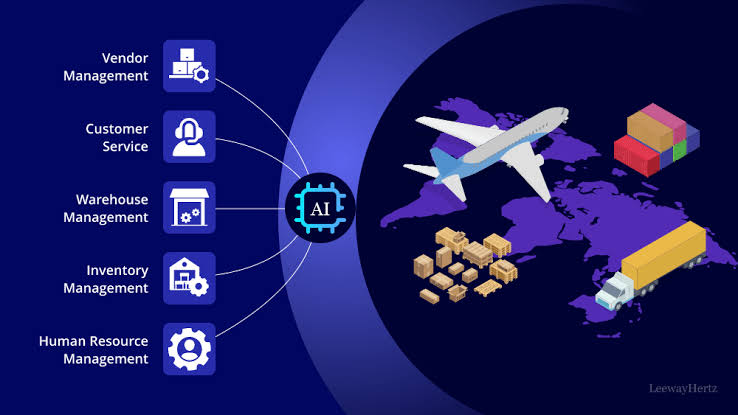Explore how AI-driven supply chain optimization enhances logistics and distribution. Discover the benefits of improved demand forecasting, route optimization, and inventory management. Learn about the challenges of implementing AI and the future trends shaping supply chain management for greater efficiency and customer satisfaction.
Optimizing Supply Chains with AI Technology Improving Logistics and Distribution.
In todays rapid and globally interconnected environment the effectiveness of supply chains significantly impacts a companys success. With the goal of meeting consumer needs while managing expenses integrating intelligence (AI) into supply chain processes has become a game changing approach. This article examines how AI powered optimization improves logistics and distribution highlighting the advantages, technologies involved and the obstacles encountered in this progress.
Understanding Supply Chain Optimization
Optimizing the supply chain means fine tuning every part of it to boost efficiency cut costs and improve customer satisfaction. This involves stages like sourcing materials manufacturing products managing transportation and delivering goods. By streamlining these steps businesses can adapt to changes in the market reduce waste and enhance their performance.
AI technology has the power to transform supply chain optimization by processing data and offering valuable insights. Tools such as learning predictive analysis and natural language processing can be used to improve decision making operations and communication throughout the supply chain.
The Impact of AI on Logistics and Distribution.
AI plays a role, in logistics and distribution by helping businesses predict demand optimize routes and manage inventory. One of the uses of AI in logistics is in forecasting demand. Traditional methods often rely on past sales data which may not account for changes in the market or shifts in consumer preferences. AI can analyze data sets such, as trends seasonality and even social media sentiment to make predictions. This allows companies to adjust their production and distribution plans based on market demand reducing excess inventory and preventing stockouts.
Route optimization is another area where AI can improve logistics. By using algorithms to assess data on traffic conditions weather and delivery schedules AI can determine the most efficient transportation routes. This not saves on fuel and delivery times but also enhances customer satisfaction by ensuring prompt deliveries. For instance companies like UPS and FedEx have implemented AI powered route optimization systems to streamline their logistics processes.
AI technologies are revolutionizing inventory management. By using analytics AI can assist businesses in keeping their inventory levels by predicting changes in demand and automating the reordering process. This reduces the chances of having too much or too little stock allowing companies to run smoothly and adapt to market shifts quickly. Moreover AI can pinpoint inventory helping businesses make decisions regarding promotions or discounts.
Enhancing Visibility and Transparency
AI powered solutions offer improved visibility and transparency throughout the supply chain. By utilizing data analytics businesses can monitor shipments, track inventory levels and evaluate supplier performance. This enhanced visibility helps companies identify bottlenecks, inefficiencies or potential disruptions in the supply chain before they become major problems.
Additionally AI can enhance communication among supply chain partners. Automated systems can transmit information in time allowing for quicker decision making and collaboration between suppliers, manufacturers and distributors. This level of connectivity strengthens the resilience of the chain enabling businesses to swiftly adapt to challenges like disasters, political unrest or unexpected shifts in demand.
Improving Customer Experience
In todays world where customers have expectations AI powered supply chain optimization plays a role, in improving the customer experience. By using AI technologies businesses can ensure faster and more precise order delivery making sure customers get their products on time. Moreover AI driven personalized marketing approaches can boost customer interaction and satisfaction.
AI also has a role, in handling customer inquiries and support. Chatbots and virtual assistants can address questions related to order status, shipment tracking and returns. This allows human staff to focus on customer service tasks. As a result response times improve overall customer satisfaction.
However there are challenges associated with implementing AI in supply chain management despite its advantages. One significant hurdle is the requirement for quality data. AI algorithms depend on datasets to operate effectively. Companies need to invest in data collection, storage and management to maintain the reliability of their AI systems.
Another challenge lies in integrating AI technologies, with systems. Many companies rely on outdated systems that may not work well with AI solutions. Shifting to platforms powered by AI could demand a investment of time, resources and training. This might discourage some businesses from fully embracing these advancements.
Additionally there may be resistance to change within organizations. Employees might be reluctant to adopt processes driven by AI due to concerns that automation could jeopardize their job security. To promote a culture of acceptance and innovation effective change management strategies are crucial. This includes providing training and clearly communicating the benefits of AI.
The future of AI in optimizing supply chains looks promising as technology progresses. Emerging trends like the Internet of Things (IoT), blockchain and robotics are poised to converge with AI. Leading to advanced supply chain solutions. For instance IoT devices can offer data on inventory levels and shipment conditions. While blockchain can improve transparency and security in transactions.
By combining AI with technologies businesses can build supply chains that are tougher, more flexible and focused on customer needs. In a world where business operations are getting more intricate using AI to improve supply chains will give companies a significant edge over their competitors.
In Conclusion
The use of AI in optimizing supply chains marks a significant change in how logistics and distribution are handled. With the integration of AI technologies companies can improve predicting demand, optimizing routes, managing inventory and gaining visibility, into their supply chains. Despite facing challenges the advantages of incorporating AI into processes are considerable resulting in operational efficiency, cost savings and increased customer satisfaction. As more businesses adopt AI the future of supply chain management appears bright offering opportunities for innovation and adaptability, in an evolving marketplace.
